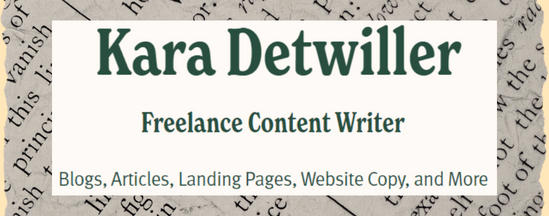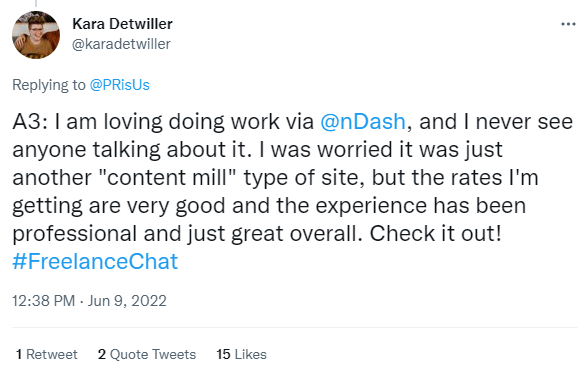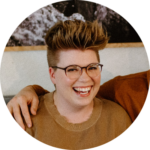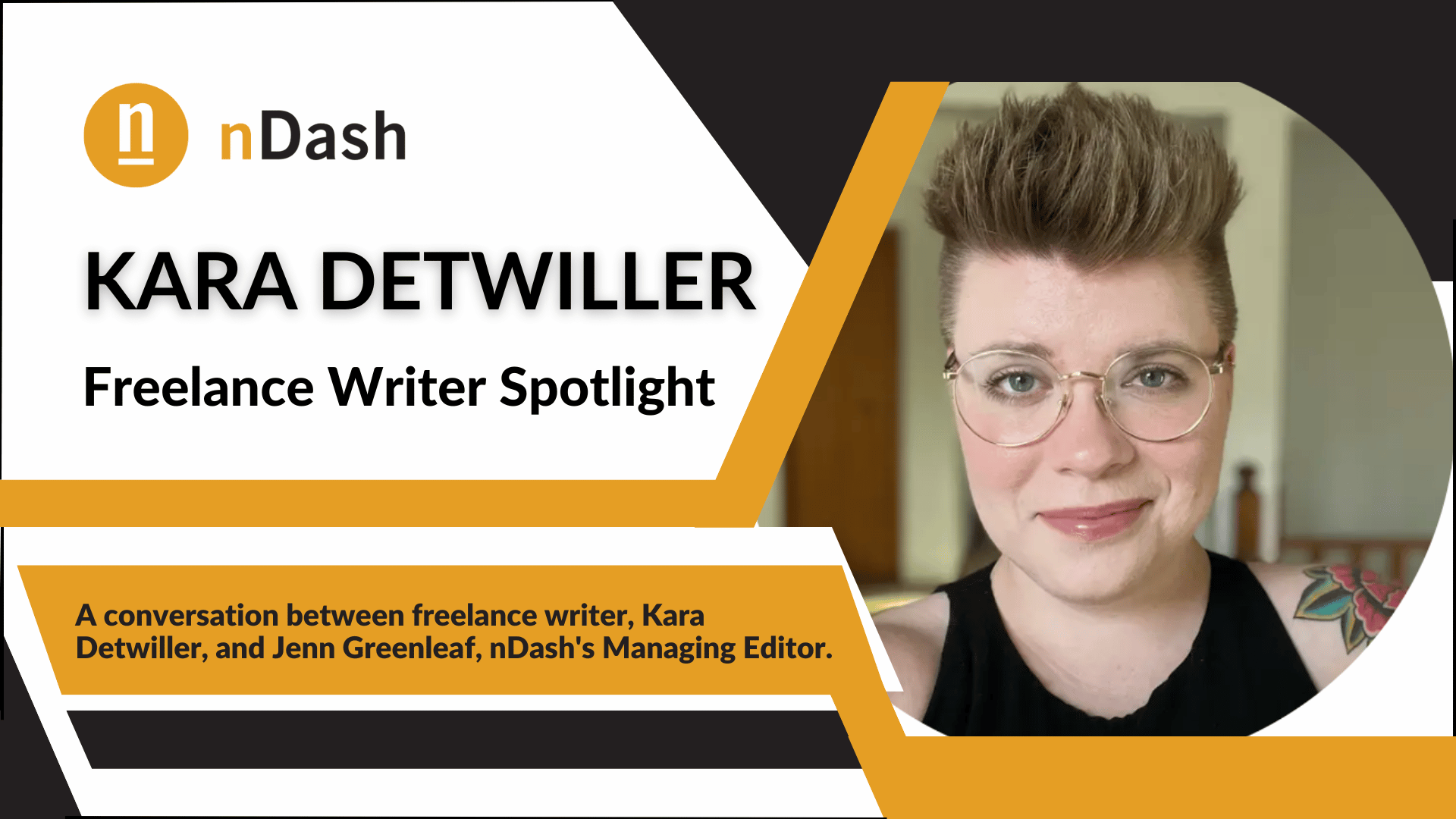nDash’s Managing Editor, Jenn Greenleaf, talks to Kara Detwiller about her transition to becoming a full-time freelance writer and much more!
Background: The Highlights
Originally from Des Moines, Iowa, Kara now calls a small town in Saskatchewan home. You can see her passion for authentic connections in her tweets – Kara Detwiller (@karadetwiller) / Twitter. One of her tweets, which she thought would be a fun prompt for her friends, unexpectedly went viral:
Her background includes being a full-time freelance writer and supporting brands as a content marketer. She mentions on her website that, in addition to freelance writing, her content marketing specialties include:
- Website content
- Blogs and articles
- SEO research and writing
Here’s a snippet from Kara’s LinkedIn profile where she explains her background and the services she provides:
“I am a freelance writer and marketing professional with a BA in Advertising from Iowa State University. I love solving problems and finding the perfect word. Experienced with content writing, SEO, copywriting, marketing strategy, social media (organic and paid), SEM, brand development, graphic design, email marketing, video editing, motion graphics, editorial and print design, and more.”
Becoming a Full-Time Freelance Writer: Kara’s Transition

Jenn: I see you’ve been a full-time freelance writer since March 2022, but your writing and marketing experience spans back as far back as 2017 (according to your LinkedIn profile). Can you tell me a little bit about why you transitioned to full-time freelance writing?
Kara: The idea of freelancing was in the back of my mind for most of my career. But it didn’t seem like a feasible option for a long time. I did some small freelance projects on the side here and there, but I just didn’t have the time or energy to take on much freelance work while working full-time.
When I got engaged to my now-husband, a grain farmer from Saskatchewan, we decided I would move to Canada to be with him after we got married. At the time, I was living in Des Moines, Iowa, and working at a digital marketing agency.
In October 2021, I quit my job, got married, and moved to Canada — all in the span of about two weeks. We now live in my husband’s tiny hometown in Saskatchewan. It’s a fairly isolated, rural community of fewer than 400 people. There aren’t many job opportunities in the area. And as an American still in the process of formally immigrating, my options are even more limited.
Jenn: When did you know it was the “right time” to transition into being a full-time freelance writer?
Kara: It really had everything to do with my situation. Getting married and having my husband’s income as a financial safety net made freelancing possible, and moving to a very remote place meant freelancing was one of my only options for work.
I briefly considered looking for a fully-remote in-house position instead of freelancing, but I really didn’t want a regular 9-5 job with a 40-hour work week. I was burned out from my previous full-time job, and the idea of working fewer hours really appealed to me.
Also, my husband’s work (farming) is obviously very seasonal, and his schedule can be pretty random. I knew freelancing would give me more flexibility and let me spend more time with him.
Jenn: Can you tell me a little about how nDash becomes part of your journey?

Kara: Yes! When I started freelancing as a side hustle several years ago, I discovered Write Jobs PLUS+, a sort of job board for writers. It costs $5/month, but I’ve found several well-paid gigs through their posts, so it has definitely been worth it for me.
One day in April 2022, an alert with the subject line “Writers wanted (graphic design)” landed in my inbox, and I was instantly interested. I was actually a full-time graphic designer earlier in my career, and I had previous experience writing about design-related topics. I responded with a very brief intro email and one relevant link, and the nDash team quickly got me set up on the platform.
Honestly, I was a little skeptical at first because I had tried other freelancing platforms and hadn’t had a great experience with them. But nDash impressed me immediately with a high level of professionalism and great rates. The nDash team really wants to make sure freelancers are treated well and paid fairly.
That first opportunity was an excellent fit for me, and I have since done many other projects with other clients on nDash, which has been awesome!
The Rest of nDash’s Discussion With Freelance Writer: Kara Detwiller
 Kara Detwiller’s background in freelance writing includes covering lifestyle and technology topics across multiple industries. Examples include cybersecurity, industrial services, finance, and more.
Kara Detwiller’s background in freelance writing includes covering lifestyle and technology topics across multiple industries. Examples include cybersecurity, industrial services, finance, and more.
Jenn: We initially started working together on projects for CorelDRAW based on your design background. Are you still working on design projects, or are you mainly focusing on writing? Did you have to make a conscious decision about focusing on writing more than design, or was it a natural transition?
Kara: When I started freelancing in March, I knew I wanted to focus on writing, but someone I worked with previously reached out to me to ask about a design project. I didn’t have much on my plate at the time, so I said yes. I quickly learned that freelance graphic design is not for me, so I now only offer writing services.
So, it was really a conscious decision based on my natural inclinations. I enjoy art and design, but I learned that I don’t enjoy doing it for clients. Writing about design topics, however, is a great way to bring my love for design into my work!
Jenn: I remember you discussing time management and your goal to prevent burnout on various social media posts. Can you give freelance writers some tips or point them to some tools to help with this?
Kara: I think my main tip for new freelancers is to not go so far in rejecting aspects of “traditional” work that you end up with no schedule and no structure. I really resisted all structure when I first started freelancing because I wanted a work experience that was totally different from my previous full-time roles. But my lack of organization quickly made me overwhelmed and stressed.
I started using a paper planner in addition to my online tools, which really helped. I write my tasks on little Post-it note flags and stick them in my planner, so I have a schedule and a way to track deadlines, but I also have the flexibility to move things around when needed.
Find a combination of analog and digital tools that help you stay organized. I also highly recommend tracking your hours — even if you don’t bill clients hourly. Having an internal record of your time helps you understand your true hourly rate. I like to keep things pretty simple, so I use one tool, Hectic, for almost everything, including project management, time tracking, invoicing, proposals, etc.
Jenn: What is the best advice you’ve ever received about freelance writing?
Kara: When I first started freelance writing, I was so confused about rates. There is so much conflicting information about what to charge — and how to charge. Early on, I found that many seasoned writers said they preferred project rates to hourly or per-word rates for writing projects, and I’ve been charging project rates ever since.
As I mentioned before, keeping track of your hours is a good idea, even if you don’t charge an hourly rate. After your first few projects, you’ll have an idea of how long certain assignments take, on average, which can help you decide how much to charge for similar projects. nDash has a fantastic rate guide I have referenced many times.
Jenn: How has your background in marketing helped support your freelance writing career?
Kara: My marketing roles, especially my time working at a digital marketing agency, gave me a well-rounded skill set. I have dabbled in many different marketing projects, including print design, motion graphics, social media, Google ads, community management, and video scripts.
Although I mainly do long-form content writing now, my past experiences help me understand clients’ overall marketing efforts and make me a more effective collaborator.
Jenn: What characteristics of an assignment excite you and don’t give you pause before accepting them?
Kara: I love when clients know what they want and have a clear creative brief or outline for me to work from. Far from stifling my creativity, it helps establish expectations and gives me a sort of scaffolding on which to write. Some clients want you to take a vague idea and “run with it,” but that can end up with more back-and-forth revisions in the end.
Jenn: Are the bulk of your assignments sent directly to you by brands or managing editors (like me!)? Or do you have to budget time on your calendar for pitching?
Kara: Both! Right now, most of my assignments come directly from brands and editors that I have established connections with, but I try to keep an eye on Twitter, LinkedIn, and Write Jobs PLUS+, just in case the perfect opportunity pops up. 😉
Jenn: What steps are you taking to grow your career over the next few years?
Kara: I’m pursuing projects that are interesting and well-paid. And I’m continuously checking in with myself to make sure my assignments are fulfilling and my work-life balance feels right. I love to write, and I can see myself writing until the day I die. But it has to be a sustainable, enjoyable thing, or I’ll get burned out (again).
To me, growth also looks like building relationships with other freelancers. Although I’m a new freelancer myself, I would love to create resources to help other people start freelancing. I think we’re going to see the nature of work changing a lot in the coming years. I’m excited to witness that!
Thank you for chatting with us about your path to becoming a full-time freelance writer and everything in between!
Work With Kara Detwiller on nDash Today!
Do you have a project that aligns with Kara’s background? Check out her writer profile to see her work and how her experience can help level up your content strategy: Kara Detwiller.
